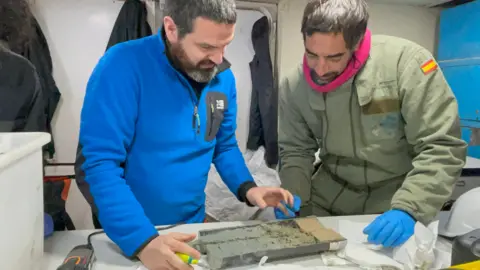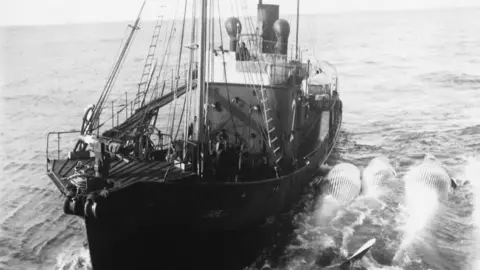AI Research
Antarctic Ocean secrets hidden in layers of seafloor mud

Science correspondent, BBC News
 Elisenda Balleste
Elisenda BallesteBBC News science team
Why would anyone brave hand-numbing cold, icy winds and rough seas – sometimes working through the night – to dig up mud from the Antarctic seabed?
That is what an international team of particularly adventurous researchers did earlier this year in the remote Antarctic Peninsula, on a mission aiming to reveal centuries of scientific secrets about the Southern Ocean.
Scientists around the world will now share and analyse these precious mud samples to work out how human activity – including a century of industrial whaling – affected Antarctica and the rest of our planet.
The research is part of a global effort to understand the relationship between the ocean and the climate.
 Elisenda Balleste
Elisenda BallesteA history of ocean life
Researchers used a special coring drill – a bit like a huge apple-corer – tethered to a research ship, to drill at depths of up to 500m.
They collected more than 40 long cores, or tubes, of seafloor sediment from locations around the peninsula.
This is one of the richest habitats for marine life in Antarctica, and a focal point for fishing, tourism and – before it was banned in the 1980s – industrial whale hunting.
Collecting the sediment gives insight and clues to the past, “like a book of history”, explained lead researcher Dr Elisenda Balleste from the University of Barcelona.
“What is living in the seas now, what was living in the seas in the past and evidence of our human impact” is recorded in layer upon layer of sediment over centuries, she said.
By preserving and dating those layers, and analysing what they contain, researchers can build a picture of the history of Antarctic marine life.
 Victoria Gill/BBC
Victoria Gill/BBCOnce on board the ship, the cores were frozen and transported to Barcelona and Dr Balleste’s laboratory.
From there, carefully extracted pieces of this Antarctic mud will be sent out to several academic institutions around the world.
Scientists will scan and date the sediment layers, work out what microbial life they contain, measure levels of pollution and calculate how much carbon is buried in the mud.
It is part of a mission – the Convex Seascape Survey – which involves universities and research institutions around the globe working together to better understand how our ocean and climate are connected.
Claire Allen, an oceanographer from the British Antarctic Survey who has studied Antarctica’s past for more than 20 years, said that cores like these were particularly valuable.
“Before 1950 – before there was any kind of monitoring capacity in Antarctica – sediment cores and ice cores are the only way that we can get an insight into any of the climatic or physical properties that have changed over time,” she said.
 Elisenda Balleste
Elisenda BallesteThe DNA fingerprint from whale hunting
The newly collected samples being stored for DNA analysis have to be kept at temperatures low enough to stop all biological processes.
Dr Balleste took them out of the industrial-sized freezer where they are being stored to show them to us, very briefly.
“They’re kept at minus 80 degrees to stop them degrading,” she explained.
These small pieces of the seabed – frozen in time at temperatures that preserve genetic material – will be used for what is known as environmental DNA analysis.
It is an area of science which has developed rapidly in recent years. It gives researchers the ability to extract genetic information from water, soil and even air, like a fingerprint of life left behind in the environment.
 Getty Images
Getty ImagesDr Carlos Preckler, from King Abdullah University in Saudi Arabia, is leading this part of the research and will be trying to measure how almost a century of industrial whaling in Antarctica affected the ocean and our atmosphere.
Carbon – when it is released into the atmosphere as carbon dioxide – warms up our planet like a blanket.
So, as the world struggles to reduce those emissions, any processes that absorb and lock significant amounts of carbon might help to rein in global warming.
“We know whales have a lot of carbon in their bodies, because they are huge animals,” said Dr Preckler.
What he and his colleagues want to know is how much of that carbon gets buried in the seafloor – and locked away from the atmosphere – when the animals die.
“We can measure whale DNA and the carbon in the sediment,” explained Dr Preckler.
“So we can measure what happened before industrial whaling removed most of the whales in the [Southern] ocean,” he added.
That, the researchers say, will provide a measure of how much whales – simply by existing, being huge and living out their natural lives – remove carbon from our atmosphere and help in the fight against climate change.
AI Research
Love and Artificial Intelligence – cbsnews.com
AI Research
NFL player props, odds, lines: Week 2, 2025 NFL picks, SportsLine Machine Learning Model AI predictions, SGP

The Under went 12-4 in Week 1, indicating that not only were there fewer points scored than expected, but there were also fewer yards gained. Backing the Under with NFL prop bets was likely profitable for the opening slate of games, but will that maintain with Week 2 NFL props? Interestingly though, four of the five highest-scoring games last week were the primetime games, so if that holds, then the Overs for this week’s night games could be attractive with Week 2 NFL player props.
There’s a Monday Night Football doubleheader featuring star quarterbacks like Baker Mayfield, C.J. Stroud and Justin Herbert. The games also feature promising rookies such as Ashton Jeanty, Omarion Hampton and Emeka Egbuka. Prop lines are usually all over the place early in the season as sportsbooks attempt to establish a player’s potential, and you could take advantage of this with the right NFL picks. If you are looking for NFL prop bets or NFL parlays for Week 2, SportsLine has you covered with the top Week 2 player props from its Machine Learning Model AI.
Built using cutting-edge artificial intelligence and machine learning techniques by SportsLine’s Data Science team, AI Predictions and AI Ratings are generated for each player prop.
Now, with the Week 2 NFL schedule quickly approaching, SportsLine’s Machine Learning Model AI has identified the top NFL props from the biggest Week 2 games.
Week 2 NFL props for Sunday’s main slate
After analyzing the NFL props from Sunday’s main slate and examining the dozens of NFL player prop markets, the SportsLine’s Machine Learning Model AI says Lions receiver Amon-Ra St. Brown goes Over 63.5 receiving yards (-114) versus the Bears at 1 p.m. ET. Detroit will host this contest, which is notable as St. Brown has averaged 114 receiving yards over his last six home games. He had at least 70 receiving yards in both matchups versus the Bears a year ago.
Chicago allowed 12 receivers to go Over 63.5 receiving yards last season as the Bears’ pass defense is adept at keeping opponents out of the endzone but not as good at preventing yardage. Chicago allowed the highest yards per attempt and second-highest yards per completion in 2024. While St. Brown had just 45 yards in the opener, the last time he was held under 50 receiving yards, he then had 193 yards the following week. The SportsLine Machine Learning Model projects 82.5 yards for St. Brown in a 4.5-star pick. See more Week 2 NFL props here.
Week 2 NFL props for Vikings vs. Falcons on Sunday Night Football
After analyzing Falcons vs. Vikings props and examining the dozens of NFL player prop markets, the SportsLine’s Machine Learning Model AI says Falcons running back Bijan Robinson goes Over 65.5 rushing yards (-114). Robinson ran for 92 yards and a touchdown in Week 14 of last season versus Minnesota, despite the Vikings having the league’s No. 2 run defense a year ago. The SportsLine Machine Learning Model projects Robinson to have 81.8 yards on average in a 4.5-star prop pick. See more NFL props for Vikings vs. Falcons here.
You can make NFL prop bets on Robinson, Justin Jefferson and others with the Underdog Fantasy promo code CBSSPORTS2. Pick at Underdog Fantasy and get $50 in bonus funds after making a $5 wager:
Week 2 NFL props for Buccaneers vs. Texans on Monday Night Football
After analyzing Texans vs. Buccaneers props and examining the dozens of NFL player prop markets, the SportsLine’s Machine Learning Model AI says Bucs quarterback Baker Mayfield goes Under 235.5 passing yards (-114). While Houston has questions regarding its offense, there’s little worry about the team’s pass defense. In 2024, Houston had the second-most interceptions, the fourth-most sacks and allowed the fourth-worst passer rating. Since the start of last year, and including the playoffs, the Texans have held opposing QBs under 235.5 yards in 13 of 20 games. The SportsLine Machine Learning Model forecasts Mayfield to finish with just 200.1 passing yards, making the Under a 4-star NFL prop. See more NFL props for Buccaneers vs. Texans here.
You can also use the latest FanDuel promo code to get $300 in bonus bets instantly:
Week 2 NFL props for Chargers vs. Raiders on Monday Night Football
After analyzing Raiders vs. Chargers props and examining the dozens of NFL player prop markets, the SportsLine’s Machine Learning Model AI says Chargers quarterback Justin Herbert goes Under 254.5 passing yards (-114). The Raiders’ defense was underrated in preventing big passing plays a year ago as it ranked third in the NFL in average depth of target allowed. It forced QBs to dink and dunk their way down the field, which doesn’t lead to big passing yardages, and L.A. generally prefers to not throw the ball anyway. Just four teams attempted fewer passes last season than the Chargers, and with L.A. running for 156.5 yards versus Vegas last season, Herbert shouldn’t be overly active on Monday night. He’s forecasted to have 221.1 passing yards in a 4.5-star NFL prop bet. See more NFL props for Chargers vs. Raiders here.
How to make Week 2 NFL prop picks
SportsLine’s Machine Learning Model has identified another star who sails past his total and has dozens of NFL props rated 4 stars or better. You need to see the Machine Learning Model analysis before making any Week 2 NFL prop bets.
Which NFL prop picks should you target for Week 2, and which quarterback has multiple 5-star rated picks? Visit SportsLine to see the latest NFL player props from SportsLine’s Machine Learning Model that uses cutting-edge artificial intelligence to make its projections.
AI Research
What Is One of the Best Artificial Intelligence (AI) Stocks to Buy Now? – The Motley Fool
-

 Business2 weeks ago
Business2 weeks agoThe Guardian view on Trump and the Fed: independence is no substitute for accountability | Editorial
-
Tools & Platforms1 month ago
Building Trust in Military AI Starts with Opening the Black Box – War on the Rocks
-

 Ethics & Policy2 months ago
Ethics & Policy2 months agoSDAIA Supports Saudi Arabia’s Leadership in Shaping Global AI Ethics, Policy, and Research – وكالة الأنباء السعودية
-

 Events & Conferences4 months ago
Events & Conferences4 months agoJourney to 1000 models: Scaling Instagram’s recommendation system
-

 Jobs & Careers3 months ago
Jobs & Careers3 months agoMumbai-based Perplexity Alternative Has 60k+ Users Without Funding
-

 Podcasts & Talks2 months ago
Podcasts & Talks2 months agoHappy 4th of July! 🎆 Made with Veo 3 in Gemini
-

 Education2 months ago
Education2 months agoVEX Robotics launches AI-powered classroom robotics system
-

 Education2 months ago
Education2 months agoMacron says UK and France have duty to tackle illegal migration ‘with humanity, solidarity and firmness’ – UK politics live | Politics
-

 Podcasts & Talks2 months ago
Podcasts & Talks2 months agoOpenAI 🤝 @teamganassi
-

 Funding & Business3 months ago
Funding & Business3 months agoKayak and Expedia race to build AI travel agents that turn social posts into itineraries




